Lauro Lines MS Surriento – Ex MS Santa Maria 1928-1940, USS
Barnett 1940-1948
Please Note: Firefox and some other search engines are not
suitable – Use “Internet Explorer” for this page to load perfectly!
Click the logo above to reach
the ssMaritime FrontPage for News Updates & “Ship of the Month”
With Reuben
Goossens
Maritime Historian, Cruise‘n’Ship
Reviewer, Author & Maritime Lecturer
Please Note: All ssMaritime and
other related maritime/cruise sites are 100% non-commercial and privately owned.
Be assured that I am NOT associated with any shipping or cruise companies or
any travel/cruise agencies or any other organisations! Although the author has
been in the passenger shipping industry since 1960, although is now retired but
having completed around 680 Classic Liners and Cargo-Passengers Ships features I trust
these will continue to provide classic ship enthusiasts the information the are seeking,
but above all a great deal of pleasure!
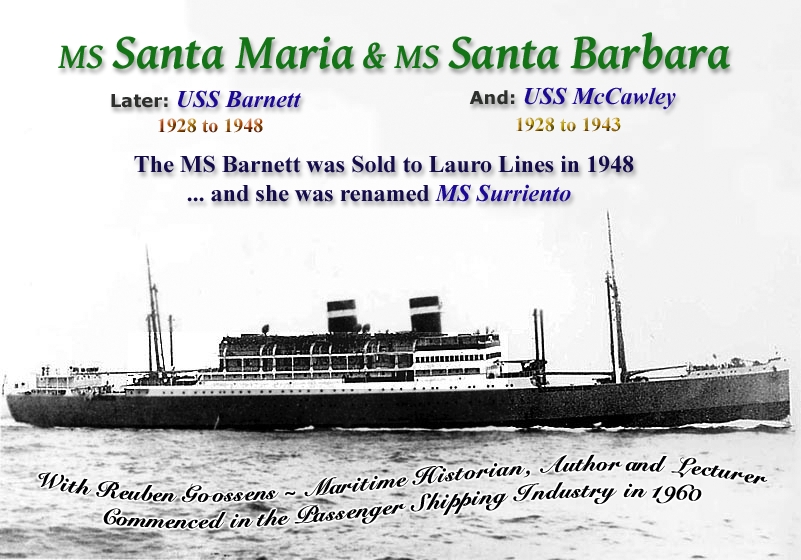
Please Note: I will deal with the MS Surriento on Page Two!
Photographs on these pages are from
the author’s private collection
Introduction:
The Lauro Lines Motor Ship, MS Surriento was originally built as the all First Class passenger Liner; 7,857 GRT (Gross Registered Tons) MS Santa Maria (2), which was named after an 1884 built 844-ton vessel. She was built at the same time as her identical sister the 7,858 GRT Santa Barbara (2), which was named after a 1916 built 4,846-ton ship, which was sunk during WWI.
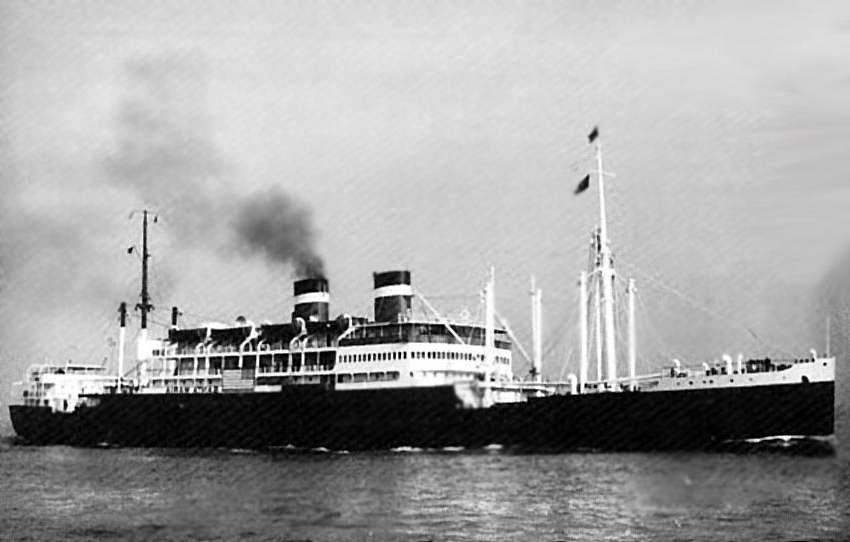
MS
Santa Maria is seen here late 1939 or early 1940 as the
the both sides of her Promenade deck of
the ship, revealing that the
For the American’s the Santa Maria and Barbara were quite a novelty at the time, because it was extremely unusual for American ships to be built in another country and both ships were built by the Furness Shipbuilding Company, Haverton in the United Kingdom in 1927/28, for the American Shipping Company “Grace Lines.”
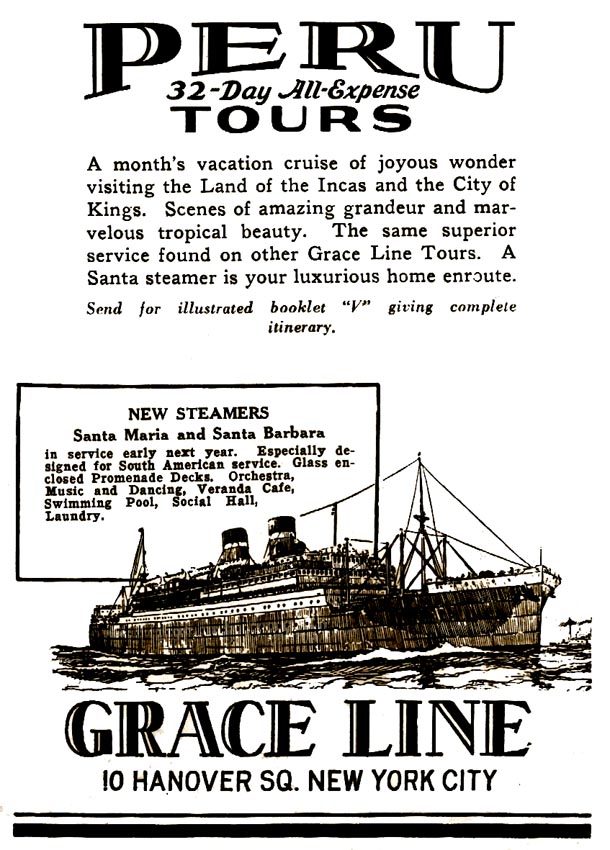
Here we see a 1927 pre-completion Grace Line
Advertisement that was placed in an American Travel Magazine
The
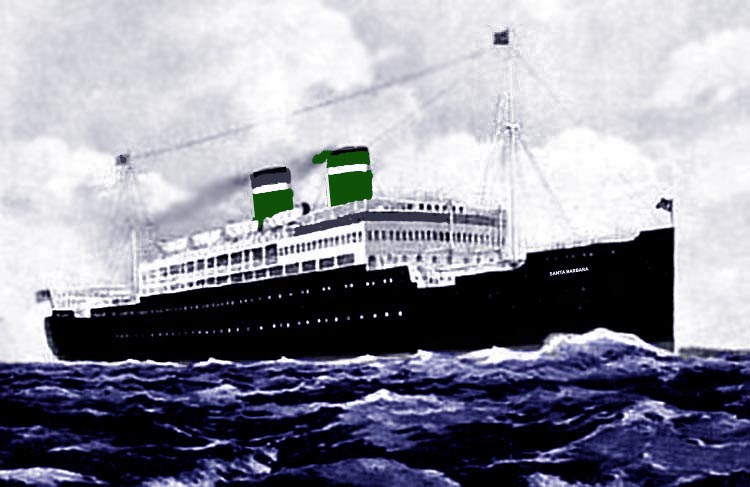
Here we see an advance publicity artist impression
postcard of the
the artist added smoke coming from the forward funnel;
strange because it is a non-functioning dummy!
It certainly could not be said that they were the most attractive looking liners ever built for the service for they were rather “boxy” looking ships with their vertical sharp bow and angular three decks amidships superstructure. However, the designers did attempt to give them a somewhat grander “Ocean Liner” look by giving them two funnels, being slightly slanted, however the forward funnel was a useless dummy, with the aft funnel containing all the exhaust piping. Each ship were fitted with two 8-cylinder, 2 cycle Sulzer Diesel Engines, capable of 4,000 BHP each making a total of 8,000 BHP and sailed at a service speed of 17 knots, but they had a top speed of 18.5 knots.
These ships certainly did offer all the traditional
Grace Line Luxuries and style, as the company’s service and superb
cuisine was along established one of excellence, and people had sailed with
them knowing that only the best would do! Onboard there were superbly furnished
Social Hall (Main Lounge), the elegant Smoking Room and the ever popular
Veranda Café. The glass enclosed Promenade Deck was always a popular feature
and it was the place to have your cup of hot morning Bouillon whilst chatting
with friends. There was a Gym and of course an excellent Swimming Pool.
Although these ships were relatively small, yet they had everything any of the
great Trans-Atlantic passenger liners could offer, but on a far smaller and a
more intimate scale!
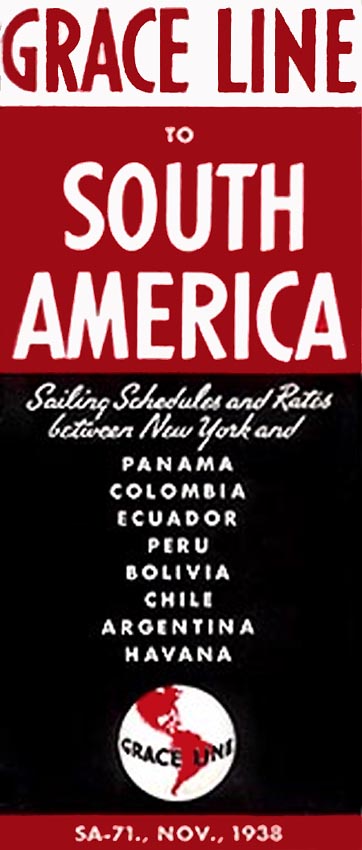
Grace Line: “Sailing Schedules and
Rates” (fares) between
for MS Santa Maria &
Provided with thanks to Björn Larsson of; www.timetableimages.com/maritime/index.htm
Their livery was traditional Grace Line of the day: An all black hull and a white superstructure, the traditional green funnels with a white band and a black top, together with the two tall masts it did make them look better. Besides being passenger liners, both ships also had considerable cargo capabilities having five spacious holds each, three forward and two aft. The holds were serviced by six sets of kingposts combined with their derricks. The masts and kingposts were all painted white completing the official Grace Line’s colours. At some time later, around 1930, due to increasing passenger demand, both ships had their accommodations increased to 172 First Class passengers.
Varied schedules between 1928-39:
Sailings during 1928 and 1931 sailings the Santa Barbara & Santa Maria operated between New York and Valparaiso sailing via Havana, Cristobal, Balboa, Buenaventura, Guayaquil, Talara, Salaverry, Callao, Pisco, Mollendo, Arica, Iquique, Tocopilla, Antofagasta, Chañaral, Coquimbo and New York.
Then as from 1932 sailings were as followed; New York, Cristobal, Balboa, Talara, Callao, Mollendo, Arica, Tocopilla, Antofagasta, Chañaral & Valparaiso and returning via Chañaral, Antofagasta, Tocopilla, Callao, Talara, Buenaventura, Balboa, Cristobal, Havana and New York.
Whilst sailings late in 1935 to late 1939 was as follows; New York, Havana, Kingston, Cristobal, Balboa, Buenaventura, Manta/Bahia, Guayaquil, Talara, Paita, Salaverry, Callao, Mollendo, Arica, Tocopilla, Antofagasta, Chañaral, Coquimbo, Valparaiso and returning via Chañaral, Antofagasta, Tocopilla, Callao, Talara, Buenaventura, Balboa, Cristobal, Havana and New York.
From November 1938 to September 1939 the service was; New York, Havana, Cristobal, Balboa, Buenaventura, Guayaquil, Talara, Salaverry, Callao, Mollendo, Arica, Iquique, Tocopilla, Antofagasta, Chañaral, Coquimbo, Valparaiso & San Antonio to New York.
New Ships Livery:
MS Santa Maria and
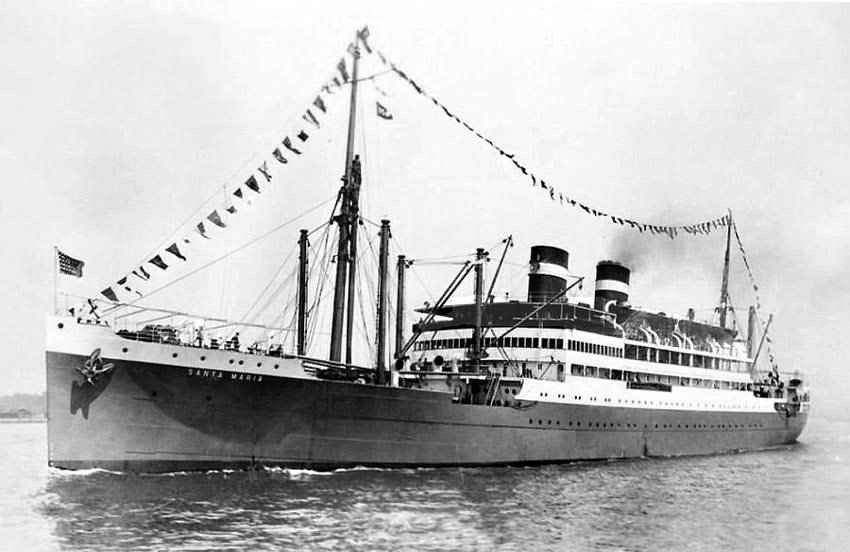
Above and below: Here we see the both the MS
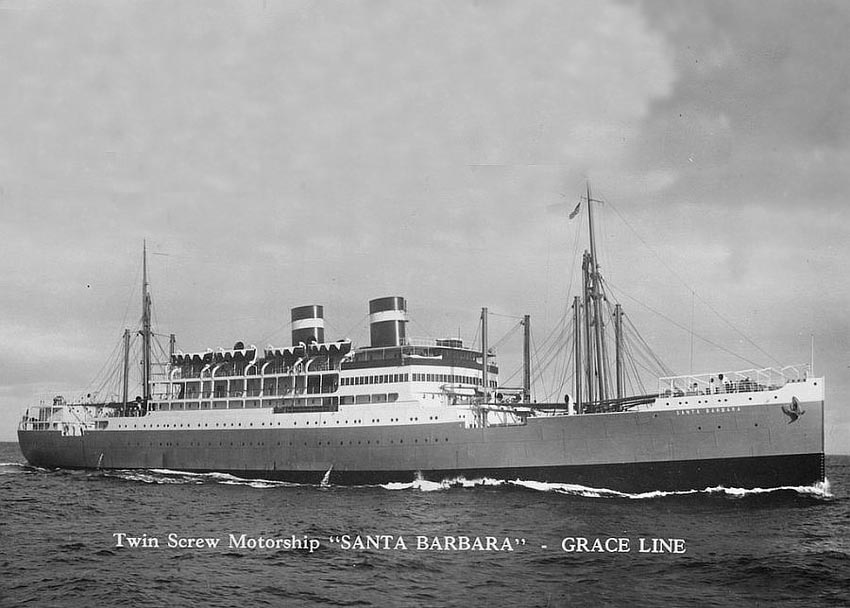
But then sadly suddenly World War II tragically happened to get in the way of their illustrious twelve-year passenger career! Suddenly it their time with Grace Line came to an abrupt end for these two fine ships as they had, according to the Constitution, go to War!
USS Barnett AP-11 & APA-5:
The Santa Maria was sold to the US Navy on August 9, 1940 and was send for a refit to Converted by Tietjen & Lang (Todd), Hoboken, N.J. to become a Navy Transport ship for 1,800 troops and she was given the Naval hull number of AP-11. She was fitted with a single 5 inch Gun mount in addition four 3 inch Gun mounts, plus eight .50 Calibre Machine Guns making her ready for anti aircraft defence.
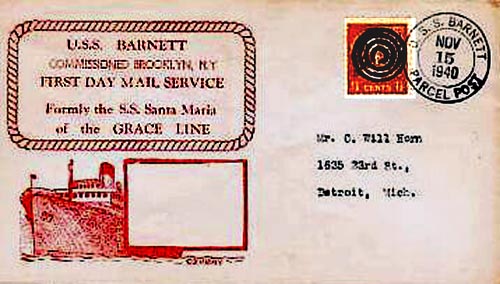
The AP-11 was officially commissioned in
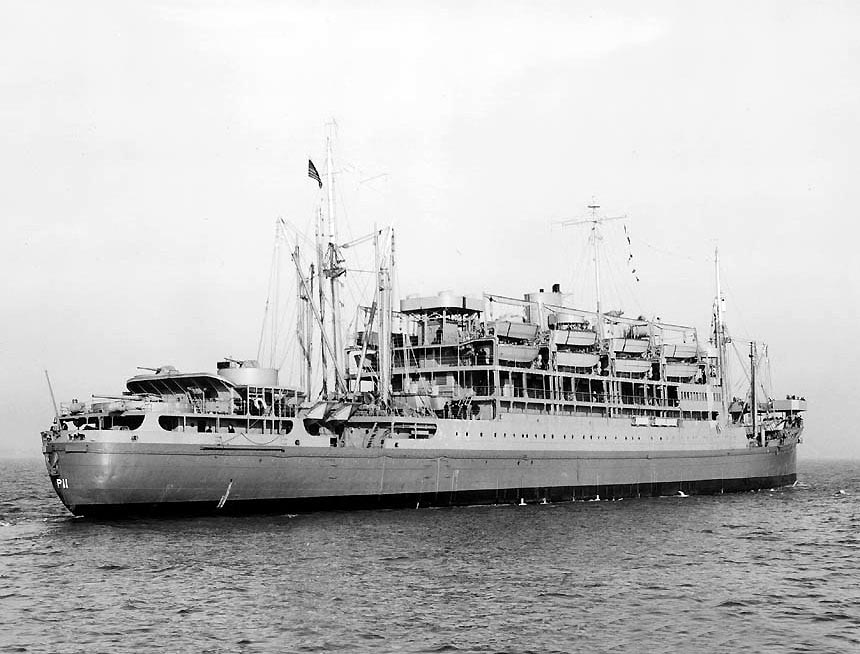
A great view of her starboard aft quarter, late in 1940 in her Grace Line late hull livery
Photographer and source is unknown – Please see the photo notes at
bottom of the page!
But soon enough, in January 1941 the USS
Burnett was recalled to
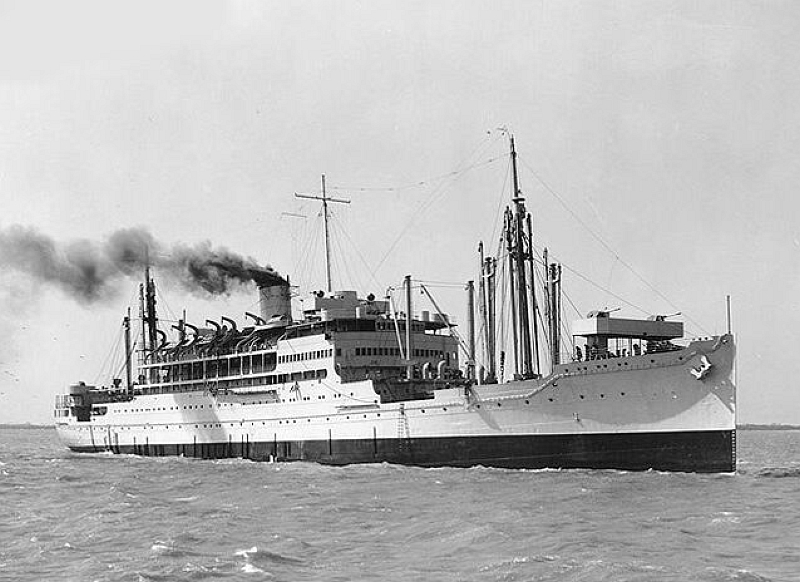
The USS Barnett AP-11 having been painted all white
as seen in 1941 during her training ship service
During World War II USS Barnett operated both in the
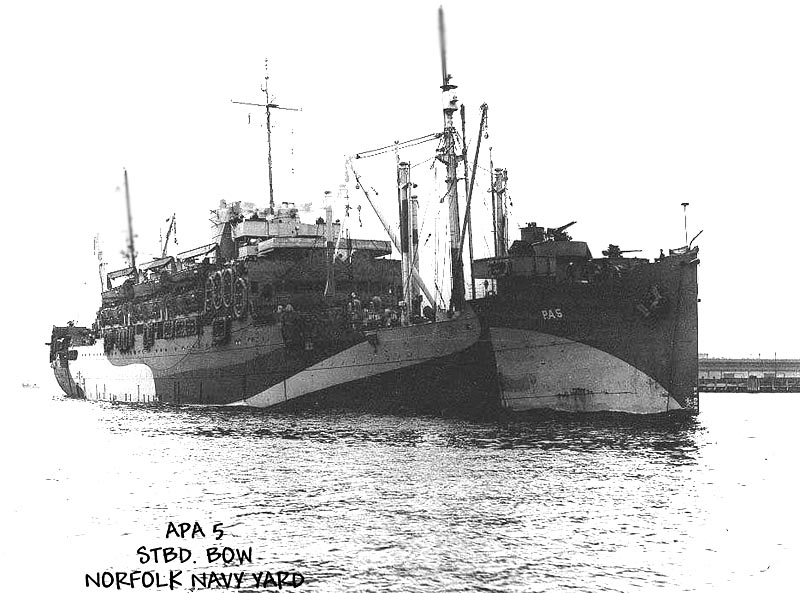
Here we see her as the USS Barnett APA-5
On February 1, 1943 she had received her camouflage paintwork and was officially reclassified as being an attack transport ship with the new hull number of APA-5 and she was kept very busy during many operations, including: The capture and defence of Guadalcanal, (August 9 and November 28, 1943); the Sicilian occupation (July 10 to 15, 1943); Landings at Salerno (September 9 to 12), the invasion of Normandy (June 6 to 19, 1944), as well as the invasion of Southern France (15 August 14 & September 25, 1944); and the assault and occupation of Okinawa (April 1 to 9, 1945).
However, during a bombing attack off the coast
of
The USS Barnett
steamed under her own power to
The USS Barnett was awarded “Seven Battle Stars” for her World War II service, but with her duties now at an end, on July 3 she was transferred to the Maritime Commission, and she was laid up with a countless of other of ships in the James River all awaiting to be sold by auction in due course, which would be in March 1948.
MS Santa Barbara
- USS McCawley APA-4:
However, her sister the
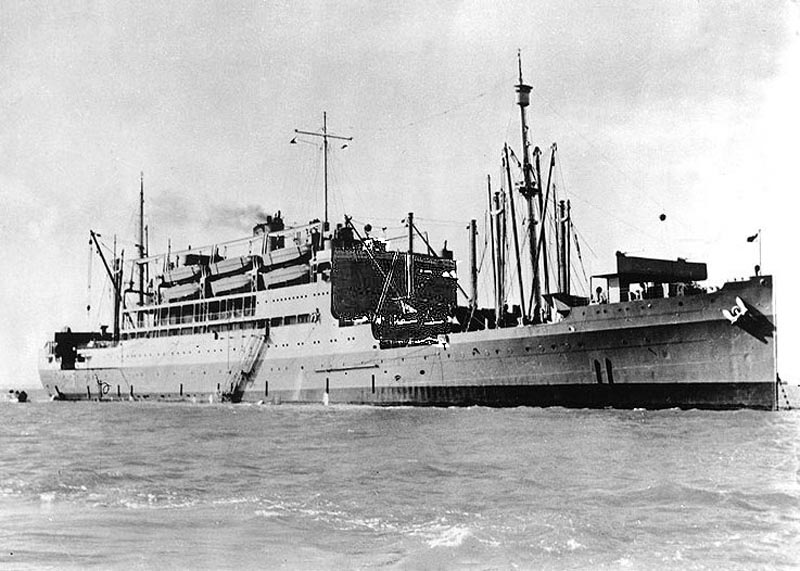
A fine photo of the USS McCawley APA-4
She served bravely in dangerous warzones as an
attack
transport ship, however on June 30, 1943 whilst she was
off-loading at Rendova Island, near New Georgia (the Solomon Islands)) the USS
McCawley was attacked the Japanese aircraft who bombed and damaged her, but not
enough to damage to sink her and she was able to continue. But much worse was
still to come for later that day, amazingly an American US PT Boat torpedoed
the USS McCawley and it hit her engine room killing 15 of her crew, as well as
knocking out all of the ships power. Therefore it was due to complete American
stupidity, sorry, wrong word, it is officially called “friendly
fire.” The USS McCawley became an American casualty of war, thanks to the
US of A, for she sank and remains a popular wreck site in the
As you can see from the specification below, there are just several very minor differences between the two ships, thus the use of their Yard numbers!
Specifications Yard
104 =
Built
by: 1927/28 - Furness Ship Building Co,
Yard No: 104 - Santa
Maria.
Yard No: 105
- Santa Barbara.
Tonnage: 104 - 7,857 GRT - 8,060 Displacement.
Tonnage: 105 - 7,858 GRT - 8,060 Displacement.
Length: 148.14m - 486ft.
Width: 19.5m - 64ft.
Draft: 7.62m –
25.1ft.
Engines: Two 8-cylinders, 2 Cycle Sulzer (
. Engines of 4,000 BHP each, a total of 8,000 BHP.
Screws: Twin.
Service
speed: 17 knots
Passengers: 1928 - 157 First Class Only.
. 1930
- 172 First Class.
Crew: Unknown.
Page Two Covers the continuing days of the ex MS Santa Maria & USS
Barnett having been sold to Mr Achille Lauro of Lauro Lines in March 1948. See the
Link below!
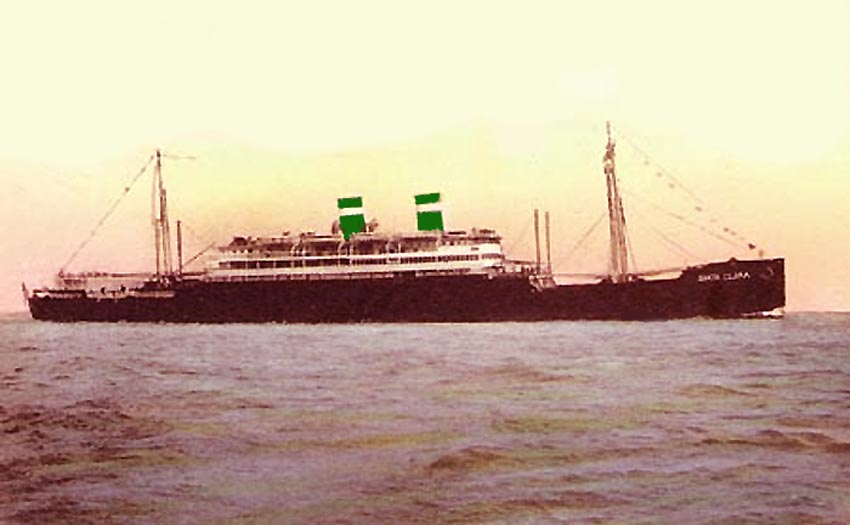
A hand painted colour postcard of the MS Santa Maria
Enter Page Two:
Other Flotta Lauro Ships:
C3 class as a cargo
ships rebuilt into Passengers liners & commenced service in 1951
MV Achille Lauro - MS Angelina Lauro
Ex
Dutch liners MS Willem Ruys (1947) & MS Oranje (1939)
“Blue Water Liners sailing to the distant shores.
I watched them come, I watched them go and I watched them die.”
****************************
Visit our ssMaritime
Main INDEX
Where you will discover well over 750 Classic
Passenger & Passenger-Cargo Liners!
ssMaritime.com & ssMaritime.net
Where the ships of the past make history & the 1914 built MV Doulos Story
Please Note: ssmaritime
and associated sites are 100% non-commercial and the author does not seek
funding or favours and never have and never will.
Photographs on ssmaritime and associate pages are either by the author or from the author’s
private collection. In addition there are some images and photographs that have
been provided by Shipping Companies or private photographers or collectors.
Credit is given to all contributors, however, there are some photographs
provided to me without details regarding the photographer or owner concerned.
Therefore, I hereby invite if owners of these images would be so kind to make
them-selves known to me (my email address can be found at the bottom of the
page on www.ssmaritime.com), in order
that due credit may be given.
ssMaritime is owned & © Copyright by Reuben Goossens - All Rights Reserved
